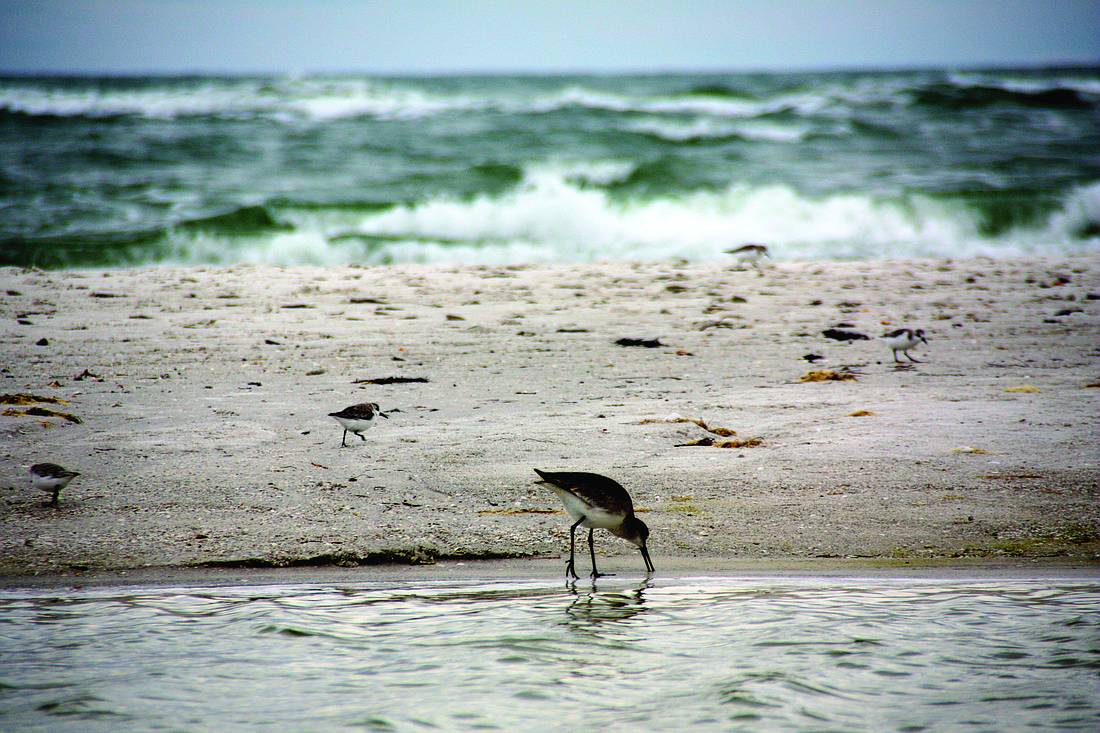- April 24, 2024
-
-
Loading

Loading

On Dec. 30, Siesta Key resident Dr. Allan Worms watched in frustration as a tractor dug a channel connecting the Gulf of Mexico to a tidal pool that had collected at the north end of Siesta Beach. The 3-foot-deep body of water spanning several acres, which had become a popular feeding area for a variety of migrant and local bird species over the winter, eventually drained through what Worms called a “rapidly widening channel.” The shorebirds that Worms was at the beach to observe that morning abandoned the area surrounding the tidal pool as swiftly as the disappearing water.
The tidal pool incident was the latest chapter in an ongoing cat-and-mouse drama between Worms and Siesta beach rake operator Mark Clippard, whom Worms has repeatedly accused of conducting illegal, off-the-books beach modifications on behalf of anonymous beachfront property owners seeking to skirt county and state environmental protection rules.
On the morning of the tidal pool incident, Worms wrote an email to the Siesta Key Association expressing his frustration: “Unfortunately, Mark Clippard apparently had tired of the tidal pool’s existence and used his tractor and a grader to dig an artificial outlet on its west side this morning … Clippard’s actions were observed by a large number of beach visitors.”
Following the Dec. 30, incident, Siesta Key Association President Catherine Luckner sent an email to the Sarasota County Commission, pressing county staff to look into the tidal pool incident, as well as Clippard’s record of violating state and county environmental protection standards.
“We don’t know who he is working for,” Luckner later said. “In my mind the people paying him are the real violators.”
Clippard, who did not return calls for comment, has consistently denied the accusations, and, due to a lack of conclusive evidence linking him to a series of illegal alterations to Siesta Beach dating back more than a year, his Florida Department of Environmental Protection beach-grooming permit remains intact.
According to state and county regulations, any grooming or modifications to beaches below the mean high-tide line require a FDEP permit.
Clippard is a licensed FDEP beach rake operator, but actions such as digging channels from tidal pools into the Gulf fall outside of what his permit authorizes.
“We’ve had numerous complaints about Clippard, and we question whether he should still have his license,” Luckner said. “If he violated the rules, he may not get his license renewed.”
In an April 2012 email to the Sarasota County Commission, Worms accused Clippard of a similar incident, claiming the beach rake operator illegally groomed a two-acre section of Siesta Beach.
In the email, Worms speculated about how the unauthorized grooming might affect the island’s shorebirds: “I expect continued grooming of that large area will exclude it as a feeding area,” he wrote.
Luckner, who said she had spoken with Clippard directly about his alleged actions, said unauthorized beach modifications not only affect wildlife, but could potentially exacerbate Siesta Key’s risk of flood surges.
“The birds are gone,” Luckner said, “but what about the shoreline? I don’t think people realize when they’re doing these modifications, they’re creating potential flood surge problems for everybody.”
In response to Worms’ and Luckner’s concerns, the County Commission tapped Matt Osterhoudt, Sarasota County conservation and environmental planning manager, to investigate. Osterhoudt led Sarasota County Natural Resources staff to inspect Siesta Beach and search for evidence of the incident Worms said he witnessed. County staff identified a narrow depression running perpendicular to the waterline, describing it as a “minor feature” that would not last long in the dynamic surf zone environment.
Osterhoudt concluded that the changes to the beach were not permanent and no enforcement action would be needed, effectively curtailing the inquiry.
“We will monitor the beach conditions to ensure that this feature is not maintained,” Osterhoudt wrote in a Jan. 8 email to County Commissioner Nora Patterson.
“The staff was a little dismissive of it and thought it was a natural process,” Patterson later said. “They thought a month or two of wind and rain and the beach would restore it.”
Osterhoudt said he reported his findings to the FDEP and the Florida Fish and Wildlife Conservation Commission — the lead state agencies for beach grooming and wildlife matters. Both agencies said they would continue to investigate.
When county staff questioned Clippard about the alleged beach alteration, he denied creating the depression — contradicting Worms’ account that he personally witnessed Clippard digging the trench.
Worms did not take any pictures to support his claims, however, leaving the officials with no evidence to justify issuing Clippard a violation.
The two agencies also contacted property owners adjacent to the site, informing them that consultation with the Natural Resources Department is required prior to any coastal modification activities other than typical grooming operations the FDEP authorizes.
“(Clippard) wouldn’t ride his tractor around doing this for no good reason,” Luckner said. “Someone is paying him to do this.”
TAKE ACTION
Area residents who wish to report suspicious beach modifications can:
• Call 861-5000 to speak with county staff.
• Call the Sarasota County Sheriff’s non-emergency line, 316-1201.
Contact Nolan Peterson at [email protected]